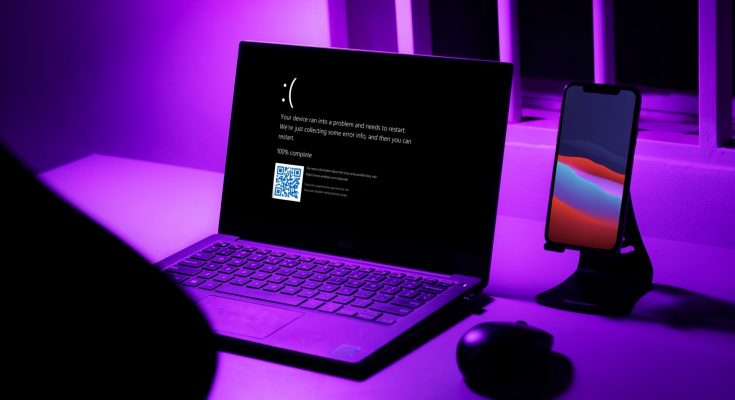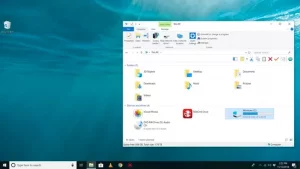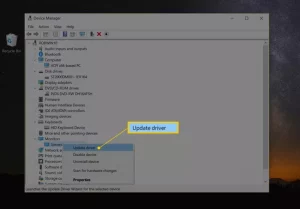A computer with a blank, blue screen is never a welcome sight. Something severely damaged the laptop, and immediate action is required to recover the system.
What Is a Blue Screen of Death? What Is the Root Cause?
A Blue Screen of Death (BSOD), also known as a STOP Error, occurs when a problem is severe enough that Windows must stop loading. It’s usually hardware or driver-related; most will display a STOP code to assist you in determining the root cause.
If the blue screen flashed and your laptop reboots, you must disable the ‘automatic restart on system failure’ setting. The steps for general Blue Screen of Death troubleshooting are listed below.
Individual STOP code troubleshooting steps can be found in our Blue Screen Error Codes List. Return here if we don’t have a troubleshooting guide for your specific STOP code or if you don’t know what it is.
This troubleshooting guide applies to all Windows versions, including Windows 10, Windows 8, Windows 7, Windows Vista, and Windows XP.
Fixing a Blue Screen of Death
The most critical Blue Screen of Death troubleshooting step is to consider what you did immediately before the device stopped working.
(1) Did you recently install a new program or piece of hardware, update a driver, install a Windows update, or something similar? If this is the case, the BSOD was most likely caused by your change.
Undo your change and re-test for the STOP Error. Some solutions, depending on what changed, could include:
- To undo recent registry and driver changes, a start-up with Last Known Good Configuration.
- To undo recent system changes, use Windows System Restore.
- I was reverting the device driver to a previous version before the driver update.
- Some of these steps may necessitate starting Windows in Safe Mode. If this isn’t possible, skip those steps.
(2) Make sure there is enough free hard drive space where Windows is installed. Blue Screens of Death and other serious issues, such as data corruption, can occur if your primary partition does not have enough free space.
Microsoft recommends keeping at least 100 MB of free space, but you’ll frequently encounter problems if you don’t. Therefore, it is generally recommended that Windows users save at least 10% of a drive’s capacity.
(3) Scan your computer for viruses and malware. Some viruses, particularly those that infect the master boot record (MBR) or boot sector, can cause a Blue Screen of Death. Check that your virus scanning software is up to date and ready to scan the MBR and boot sector.
If you can’t get far enough into Windows to run a virus scan, some tremendous free bootable anti-virus tools are available.
(4) Examine and install all Windows service packs and updates. Microsoft releases patches and service packs for their operating systems regularly, which may include fixes for the cause of your BSOD.
(5) Windows hardware drivers should be updated. Because most Blue Screens of Death are hardware or driver-related, updating drivers may resolve the STOP error.
(6) Examine the System and Application logs in Event Viewer for any errors or warnings that may provide more information about the cause of the BSOD.
- Administrative Tools can be used to access Event Viewer.
- In Device Manager, reset the hardware settings to default.
(7) Unless there is a compelling reason to do otherwise, the system resources that an individual piece of hardware is configured to use in Device Manager should be left at default. A Blue Screen of Death has been linked to non-standard hardware settings.
(8) Reset the BIOS settings to their default values. An overclocked or incorrectly configured BIOS can result in various random issues, including BSODs.
If you’ve made several changes to your BIOS settings and don’t want to reload them, at least try resetting the clock speed, voltage settings, and BIOS memory options to their default values and see if that resolves the STOP error.
(9) Check that all internal cables, cards, and other components are correctly installed and seated. Because loose hardware can cause a Blue Screen of Death, try reseating the following and then testing for the STOP message again:
- All internal data and power cables must be reseated.
- Reinstall the memory modules.
- Any expansion cards should be reseated.
(10) Perform diagnostic tests on all hardware that can be tested—free memory test programs and complex drive testing tools are available.
A failing piece of hardware is almost always the root cause of any Blue Screen of Death. So if a test fails, replace your computer’s RAM or hard drive as soon as possible.
(11) You should update your BIOS. Due to incompatibilities, an outdated BIOS may cause a Blue Screen of Death in some cases.
(12) Start your computer with only the necessary hardware.
(13) Starting your computer with the bare hardware required to run the operating system is a helpful troubleshooting step in many situations, including BSOD issues. If your computer boots up normally, it means that one of the removed hardware devices was the source of the STOP message.
Hence, the motherboard, CPU, RAM, primary hard drive, keyboard, video card, and monitor are typically the only pieces of hardware required to boot up your PC and run the operating system.
So, If you haven’t already corrected the cause of the BSOD, proceed with either the software or hardware steps below, depending on which way your troubleshooting went above.
The BSOD is cause by software
If your troubleshooting has led you to believe that a specific software program is most likely causing the BSOD, follow these steps to resolve it:
- Check for and install any available program updates. Thus, most software programs allow you to check for updates via a menu option, so look for it.
- Secondly, If you can’t or believe it’s not working, try one of these free dedicated software updater programs instead.
- Then, Install the software again. If updating does not works or is not an option, uninstall the program and reinstall it from scratch.
- For support information, contact the developer. Moreover, BSOD may be an issue the software developer has seen before and has already documented a solution for.
- Lets, try a different program.
- Hence, If there is no way to make this program work (and uninstalling it proves that it is the cause of the BSOD), then using a different but similar program may be your only option.
The BSOD is cause by hardware
If you believe that a piece of hardware is causing the Blue Screen of Death, you have several options:
- Check that the hardware is list on the Windows Hardware Compatibility List.
- While, the hardware may be incompatible with your version of Windows.
- Then, Update the firmware on the hardware.
- Just as you might update software to fix a problem with Windows, updating the hardware’s software, known as firmware, if any is available, is a good idea.
- For support information, contact the manufacturer. Their knowledge base may contain relevant information on this subject.
- Then, reinstall the hardware.
At this point, it’s likely that the hardware itself is no longer functional and remove it. Assuming that this piece of hardware was the sole cause of the BSOD.
Atlast, it should go away after you do this.
FAQ
How do I repair a Nintendo Switch Blue Screen of Death?
Therefore, the quickest way to fix a BSOD on a Nintendo Switch is to hold down the Power button for 12 seconds, then restart it.
Alternately, enter recovery mode and choose Factory Setting Without Deleting Save Data.
How do I fix a Blue Screen of Death in Windows 10?
Firstly, you must restart your computer to clear the error. Fortunately, Microsoft released an update KB5001567 to address this issue in printers manufactured by Kyocera, Ricoh, and Zebra, among others.





